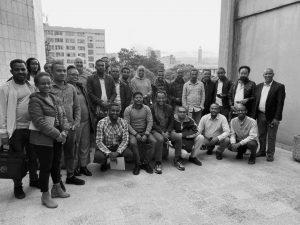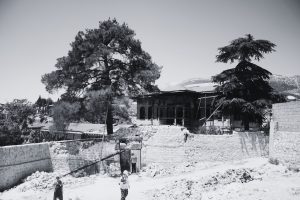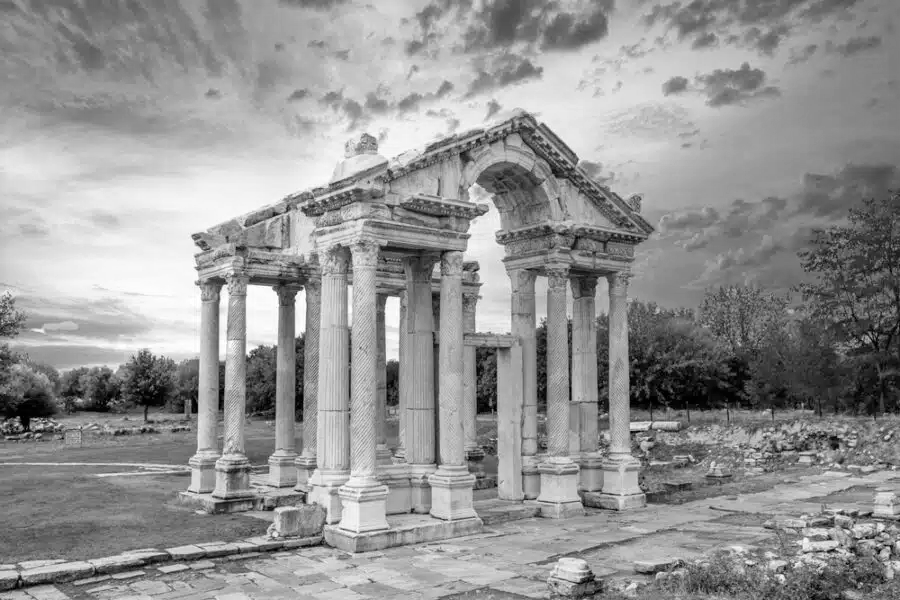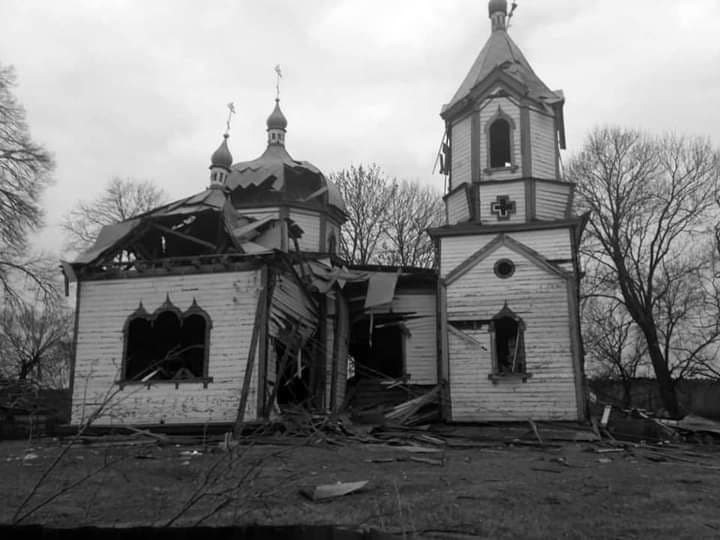: Opinion pieces
Empowering Ethiopia’s Heritage Sector: HERITΛGE’s First In-Country Workshop
Preserving cultural heritage goes beyond the institutional practices of protecting ancient structures; it involves engaging communities, understanding shared heritage values , and building a future that respects local perceptions of the past. It is with this in mind that HERITΛGE held its inaugural workshop in Ethiopia in July, training 22 key heritage managers in Community Engagement in Heritage Management.
HERITΛGE Director, Dr. Evangelos Kyriakidis, and Xanthippi Kontogianni, Ethiopia Programs Manager, held the 3-day intensive workshop in Addis Ababa, welcoming heritage professionals representing a diverse range of stakeholders within Ethiopia’s cultural and creative industries. Among the participants were representatives from a diverse range of stakeholders including Jinka University, Madda Walabu University, the Ministry of Tourism, the Ethiopian Heritage Authority, the National Library, and various civil society organizations among them the Waku Gutu Foundation, Heritage Watch, and Save Heritage, History and Culture of Ethiopia.
The workshop is part of HERITΛGE’s program for Ethiopia, supported by the Mellon Foundation’s Humanities in Place program.
Nurturing Capacity for Community Engagement
At the heart of our Communities Engagement workshop lays a commitment to building capacity within heritage management. In an ever-evolving world, local communities are keepers of key information for the understanding of heritage while accountability for protecting their own history and values is indispensable and crucial for sustainable heritage preservation. HERITΛGE has structured the workshop to address these needs comprehensively.
Throughout the workshop discussion facilitated by Dr. Kyriakidis, participants shared examples and case studies from the Ethiopian context and explored the issues affecting the the management of cultural assets in the country, highlighting among others the challenges, needs and opportunities facing heritage managers.
Workshop Outcomes:
- A Network of Collaborators: The workshop serves as a nexus for like-minded professionals to network, share experiences, and collectively envision a future where heritage management is a catalyst for positive change.
- Diverse Perspectives: With participants from universities, government bodies, regional offices, and civil society organizations, the workshop brought together diverse viewpoints, sparking enriching discussions and cross-pollination of ideas.
- Community-Centric Approach: HERITΛGE’s emphasis on community engagement resonated strongly, setting the tone for a future where heritage sites become integral to community development.
- Concrete Strategies:Participants departed the workshop armed with practical strategies to enhance community involvement, integrate local narratives, and develop sustainable heritage management plans.
Preserving History Together: Our Cultural Heritage Assessment in Kahramanmaraş
By Çağla Parlak
We are thrilled to share our recent post-earthquake cultural heritage assessment field visit to Kahramanmaraş, Turkiye, conducted in cooperation with the Association for the Protection of Cultural Heritage. This meaningful initiative was made possible through the generous funding provided by the Aliph Foundation.
Between 23-29 July, our team of dedicated conservationists assessed 175 historic buildings in the city of Kahramanmaraş, which suffered significant damage from the February 2023 earthquakes, including awe-inspiring civil architecture and time-honored monuments, each carrying the weight of centuries of history. The devastating earthquake had left its mark, reminding us of the vulnerability of our shared cultural heritage. The once-proud monuments, centuries-old buildings, and priceless artifacts bore the scars of nature’s fury, urging us to act swiftly to protect the region’s cultural treasures.
During our site visit, we focused on assessing the extent of the damage and devising restoration strategies. What touched us most was our engagement with the locals. They welcomed us with open hearts, sharing their concerns and hopes for the future of their historic houses.
Embracing Ownership and Driving Sustainable Development: Women’s Entrepreneurship in The Gambia
By Mina Morou*
Women’s entrepreneurship in The Gambia has experienced remarkable growth, empowering women and catalyzing positive societal change. From supportive collectives in rural areas to innovative ventures across sectors, women entrepreneurs are breaking barriers and leading the charge towards a more inclusive and prosperous future.
A noteworthy example of this progress is the establishment of supportive collectives in rural areas, where women pool funds from their entrepreneurial endeavors to provide support within their group. This fosters solidarity, sisterhood, and shared responsibility, offering not just financial aid but also emotional support and knowledge exchange. During our work for HerMaP Gambia, we witnessed firsthand the impactful role of women collectives in promoting women’s entrepreneurship in The Gambia. These collectives serve as networks of support, fostering collaboration, shared experiences, and mutual assistance. They create an enabling environment that empowers women entrepreneurs to thrive in their ventures.
It is very encouraging that recent research shows most women employed in Micro – SME’s state that a range of opportunities such as micro-financing and business development opportunities like training and coaching are available to them in the country.
Women’s entrepreneurship plays a pivotal role in driving sustainable development, contributing to economic growth, employment opportunities, and innovation. Moreover, women entrepreneurs prioritize community development by supporting local suppliers and investing in socially impactful initiatives such as sustainable agriculture and tourism.
However, women entrepreneurs in The Gambia face challenges including limited access to finance, cultural biases, and gender inequalities. Overcoming these obstacles requires collective efforts from the government, private sector, and civil society. It is crucial to provide targeted financial support, offer business training and mentorship programs, and promote gender-responsive policies.
Creating an enabling environment is essential for fostering women’s entrepreneurship. This involves ensuring equal opportunities for education and skills development, addressing infrastructural gaps, and challenging gender stereotypes. By encouraging women, fostering supportive networks, and creating favorable conditions, The Gambia can unlock the full potential of women entrepreneurs.
Women’s entrepreneurship in The Gambia is a potent catalyst for economic growth, social transformation, and sustainable development. By celebrating their achievements and continuously advocating for women’s entrepreneurship, we can build a more equitable and prosperous society for all. It is through the collective efforts of various stakeholders that we can ensure the thriving of women’s entrepreneurship, both within The Gambia and beyond its borders. HERITΛGE actively contributes to this mission by providing targeted training and mentorship programs that address the specific needs of women entrepreneurs, equipping them with the essential skills and knowledge for entrepreneurial success.
*Mina Morou is HERITΛGE’s African Programs Manager
HERITΛGE actively contributes to women entrepreneurship, through HerMaP Gambia, which is co – funded by the European Union.
Addressing the Challenges to Cultural Heritage in Turkey and Syria after the February 6th Earthquake
By Dr. Evangelos Kyriakidis
N.B. The following remarks were delivered during the Aliph Forum 2023 a few short weeks after the deadly February earthquakes that affected Turkey and Syria
Dealing with the challenges posed to cultural heritage in Turkey and Syria following the devastating earthquake of February 6th is a complex issue that requires a multifaceted approach. As the global heritage community responds to this catastrophe, it is crucial to consider the longstanding difficulties faced by the affected regions in Southeastern Turkey and Syria, including longstanding humanitarian and political crises affecting these countries. The earthquake has further exacerbated an already dire situation.
To effectively address this, it is essential to distinguish between regions experiencing an ongoing humanitarian disaster and those that have endured significant damage but are not facing immediate threats to human life. Immediate action should be taken to protect heritage in the latter regions, while rescue teams should be left unimpeded in their efforts to save lives in the former.
The circumstances in Syria differ significantly from those in Turkey. Prior to the earthquake, there were ongoing cultural heritage preservation and protection projects in Turkey, some of which HERITΛGE was fortunate to be involved with. One notable project, generously funded by the British Council’s cultural protection fund, focused on documenting cultural heritage in Antioch. The documentation from this project will prove invaluable in the aftermath of the disaster. Additionally, the project contributed to the development of skills in vernacular architecture, which will be vital for addressing the needs of local heritage.
HERITΛGE also participated in an Ambassadors’ Fund for Cultural Preservation project in Mardin. This city, with its well-preserved traditional stone, religious and vernacular architecture, and terraced urban layout, was fortunately spared the worst of the earthquake’s impact.
Other projects, albeit less comprehensive, documenting primarily local religious sites were underway in the region. Their findings will allow the heritage community to compare data before and after the earthquake, providing valuable insights into the extent of the damage.
Civil society in the affected area has also mobilized to address the situation. Although their numbers are limited, several groups are diligently working to document the earthquake’s impact on heritage and ensure that relevant issues are addressed. The Turkish government has also taken steps in this regard, organizing workshops to enhance the capacity of engineers who will assess the damage. Despite the incalculable loss off life, there are still people on the ground who will contribute to assessing the situation in several locations within the less severely affected areas.
Given the circumstances, it is likely that extensive collaboration will be necessary to deploy additional teams to evaluate the damage in these — i.e. the region less severely impacted by the earthquakes. This area will serve as a precedent for future interventions, mapping, and documentation efforts in the most heavily affected areas. Mapping the damage to heritage in the region will be a challenging, painstaking, and sorrowful task. However, it is an essential endeavor that must be undertaken.
* You can watch the Plenary and more from Aliph Forum 2023 here.
*Dr. Evangelos Kyriakidis is the Director of the Heritage Management Organizatio (HERITΛGE). He made these remarks during a plenary of the Aliph Forum 2023 in Abu Dhabi in early March 2023, a few weeks after the earthquake. Plenary 4 “Safeguarding cultural heritage in the aftermath of the earthquake of 6 February 2023” was chaired by Dr. Mounir Bouchenaki, ad interim Chair of the Scientific Committee, ALIPH.
Along with Dr. Kyriakidis, the speakers included:
* Mr. Luis Monréal, General Manager, Aga Khan Trust for Culture, Switzerland
* Dr. Maja Kominko, Scientific and Programs Director, ALIPH
* Dr. Sarkis Khoury, Director General of Antiquities, Lebanon
* Mr. Mehmet Balci, Co-founder, Fight for Humanity, Switzerland
* Ms. Krista Pikkat, Director, Culture and Emergency Entity, Culture Sector, UNESCO
* Mr. Yves Ubelmann, CEO, Iconem, France
The Destruction of Heritage, in Ukraine and elsewhere, is an Extreme Form of Affront to Humanity
Βy Dr. Evangelos Kyriakidis
From the start of Russia’s aggressive war in Ukraine, the importance of protecting the country’s cultural heritage was obvious to the international community.
“We must safeguard the cultural heritage in Ukraine, as a testimony of the past but also as a catalyst for peace and cohesion for the future,” Audrey Azoulay, the Director-General of UNESCO, the UN’s cultural protection agency, said at the start of the conflict.
Nearly a year onwards, international organizations and most prominently Aliph, Blue shield and CER have tried hard, yet the challenges and the devastating effects of war continue unabated. Recently, Ukraine’s President Volodymyr Zelenskyy tweeted after a phone call with the Ecumenical Patriarch, the first among equals of the Eastern Orthodox Church, that more than 200 churches have so far been destroyed by Russia since the beginning of the invasion.
Why is it that with so much being lost, Zelenskyy -himself a member of Ukraine’s Jewish community- is forcefully pointing out the wilful destruction of Ukraine’s religious sites?
Heritage, be it in the form of monuments, customs, stories, songs, old photos or other, constitutes an important part of our identity, who we think we are, our language, the groups we associate ourselves with, whom we consider kin, friend or foe. Our sensation that we share views about heritage with others gives us the feeling that we have a shared identity, makes us feel we belong somewhere. It is for that reason that heritage is the cornerstone of who we are, how we feel about ourselves, and our affiliations.
Heritage that is purportedly shared with others gains in importance and influence. If a society is a group of people that is conscious of having at least one thing in common, then a society that identifies itself as a group because of its shared heritage would consider that heritage as crucial for its existence. Historically, nations do that; they refer to a shared heritage, be it imagined or real, that defines them as a group. And that national heritage becomes a crucial reference point for all members of that nation. In the 19th century and many times since, heritage has been used to define, but also to exclude. So heritage, be it the exploits of Alexander, the Crescent and the Star, the city of Kiev, the 1389 battle of Kosovo, and so on has not only been used to define people and make them proud, it has also been used to exclude others, despite the fact that it did not have to.
Religion, like the nation, refers to a belief system that people are consciously sharing; they are therefore defined by it as individuals or as members of social groups. A religion and its key figures are figures that are greater than the self. They are therefore crucial risk adaptation mechanisms. God will always be there irrespective of the calamity that has befallen a society. Calamities indeed often are explained through religion, but, more important, the days that follow a calamity are often managed through religion. A religious site is a site that a particular religious belief system considers as important. It usually is a site that concentrates people, either because it is a site where regular religious rituals take place; because it is a pilgrimage site, a site where people are moving through or towards in order to fulfill a religious purpose; or because it is a site that is significant in the narrative of that religion (or all of the above). These sites are often vested with great importance, because they are significant in that belief system. And in case of a disaster, religious sites are sites of refuge, sites where people can find peace, where they can plan their next day, gather and continue the thread of society. There is a significant body of research, especially in the scholarship on aphasia, Alzheimer’s and storytelling, that shows how material objects, buildings or other, are great focusing points for storytelling.* In religious belief systems, religious sites are important nodes for storytelling, they are gathering sites that reconfirm social structures and norms, they are important places to connect with something that is greater than the individual, that also confirms the identity of that individual as a part of society (as that is defined here as a group of people that is conscious of having at least one thing in common).
The destruction of a site of national importance or of a site that has religious importance is not only an attack on humanity’s treasures. It is not only an affront to the international community, the treasures of human genius as some organizations would like to put it or, ultimately, our self-indulgence. It is an irreparable damage to the social groups that are defined by these sites. It is a destruction of the very foundations of their identity and therefore of their being. This often happens in times of war; climatic disasters can bring this about, too.
This is tantamount to what is called cultural genocide, attempting to eradicate from the face of this planet the testimony of a people, of a religious group. What I am arguing here, however, is that this is not about testimony. It is not about memory. It is about identity. Imagine for instance ourselves, in what we call the West, who have been raised as appreciating as a cornerstone of our existence, our civil liberties. Imagine a world with no civil liberties. We have already been given elements of a taste of that. Now imagine these civil liberties to be taken away forever and our never having the opportunity to rebuild them. What sort of world would we give to our children? What would life be like? Now imagine groups of people whose religious sites have been taken away, have been demolished, or given to another religion irrevocably. Imagine people destroying your gods. Who will protect you in times of danger, how will you teach your children how things used to be, how will a new normal come about in times of crisis? This is not about social diversity, human genius, the education of our children: this destruction is a severe, irrevocable blow to the foundations of who people are, what they live for, how they want to raise their families. Destroying heritage does that.
Finally, given that heritage sites often live for thousands of years, the systematic destruction of heritage that some parties follow through the course of decades is something that must be on the one hand seen in its totality (like the effects of hundreds of years of natural erosion on a building is seen altogether) but also be recognized as a conscious, systematic attack against the principles at the foundations of humanity (of every regime). It is a crime that most instances of genocide pale against. It is not only wiping people from the face of the earth. It is making sure they never come back. It is making sure that not even shadows exist in the underworld. Unfortunately, this last most hideous of crimes goes unnoticed and, even worse, unpunished.
Dr. Evangelos Kyriakidis is the founding Director of the Heritage Management Organization.
* Zeisel, J. I’m Still Here: A New Philosophy of Alzheimer’s Care (2009)
*This article was first published in St. John’s University School of Law’s Law and Religion Forum and was slightly adapted to address recent development following Russia’s invasion of Ukraine in February ‘22.





